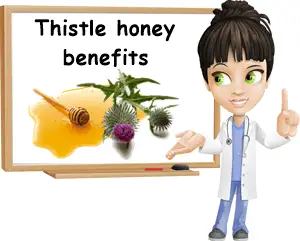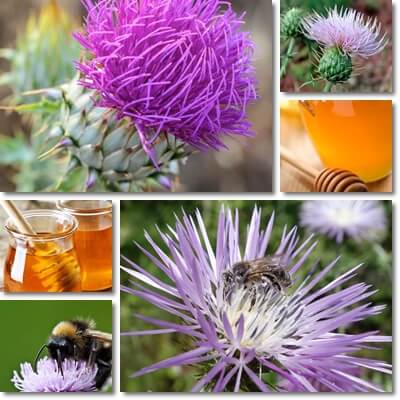Thistle is a term referring to an entire family of similar-looking plants with prickly leaves and stems and cup-like purple, yellow or whitish flower heads. Thistles are part of the larger daisy or sunflower family and are excellent sources of nectar, a characteristic that makes them ideal for honey production. Depending on the number of different species present in the same area and considering the fact that honey bees do not discriminate between the nectar sources they have access to, the resulting honey can be either from a single flower or from multiple, closely related thistles.
Whether it’s from a single flower type or several different thistle varieties, thistle honey is healthy and generally has about the same range of properties. Its most noteworthy health benefits include a strong energizing effect, natural antibacterial properties, hepatoprotective action and beneficial effects on digestion. However, considering that the daisy family thistle is a part of has significant allergenic potential and the fact that honey contains actual pollen from the flowers, it is possible for thistle honey to trigger an allergic reaction, particularly in people with an existing allergy to daisies, thistle or their pollen.

What should you know about thistle honey? As mentioned above, this type of honey can be made from the nectar of a single variety of thistle or several closely related varieties that happen to grow in the same area a colony of honey bees may visit. This means you can get single-flower thistle honey (such as yellow star thistle, purple star thistle, Cardoon or Italian thistle honey etc.) or a mix called thistles honey. In any case, the source of the honey should be mentioned on the label. Because the varieties are of the same family and have similar properties, their honeys have similar health effects, meaning you can enjoy roughly the same benefits from any type of thistle honey you may choose.
What does thistle honey look like? Just like different varieties have differently colored flowerheads, so do different honeys have different colors. Overall, color may range from a very light, almost clear amber to dark amber. The lighter honeys tend to be more see-through, while the medium amber ones may have golden-greenish reflexes. Compared to acacia or other types of honey, thistles honey crystallizes rather fast, in a matter of months as a result of its higher glucose content. The lighter-colored crystallized honeys have a yellowish beige color to them, while the darker-colored crystallized ones have a dark yellow or orange tint.
What does thistle honey taste and smell like? Again, different varieties may have different flavor profiles. Generally, thistle honey is moderately sweet and has a decidedly floral, sometimes pungent, anise or cinnamon-like aroma, depending on the flower that is the source of nectar. Some thistle honeys have a simple, mildly sweet taste. Others have a slightly spicy, pungent aroma, with anise or cinnamon influences. There are also those with a more complex taste profile, reminiscent of molasses, with earthy, grassy notes.
Overall, the lighter thistle honeys have a finer sweet taste, while the darker ones have a rich, grassy, spicy flavor, but with a medium taste intensity. Other words that can be used to describe the taste of different types of thistle honey include: sweet-floral or fruity-floral, lasting sweetness, grassy or earthy odor, bitter leather or almond notes, sharpness of taste. As far as texture is concerned, thistle honeys have a thick consistency. If the honey appears liquid, it has probably been processed, heated or is not real (it is possible to produce fake honey from sugar, corn syrup and other cheaper, refined ingredients), in which case it is likely not very healthy or suited for consumption.

What is thistle honey good for?
Most of the health effects of thistle honeys are derived from the properties of the plant varieties providing the nectar and the interaction of plant nectar and pollen elements with the enzymes from honey bees. The honey is best consumed in small amounts and only by those who are not allergic to it. Overall, the following 6 benefits stand out:
1) Antimicrobial activity. All honey varieties (except manuka honey) owe their antimicrobial activity to a variable content of hydrogen peroxide. Hydrogen peroxide is a naturally occurring antiseptic and antimicrobial formed as a result of the interaction between glucose from honey and a special enzyme secreted by bees and called glucose oxidase. It has been suggested that the amount of glucose oxidase present in honey determines its antimicrobial potential. However, it has been shown the the low pH and low moisture content also play a part.
Because of its natural antiseptic effect, thistle honey boasts a variety of uses. In my opinion, one of its most notable applications is as a face mask to improve skin appearance, clear pores and improve the appearance of acne scars or blemishes. In my experience, when used daily or every other day, it helps reduce bacterial load and prevents acne breakouts. Moreover, I find the light-colored varieties have an illuminating effect, being perfect for correcting skin dullness and uneven skin tone (I have different shades of yellow in my face).
The honey can be eaten to reduce throat soreness and shorten recovery time in cases of respiratory infections. However, if you add it to tea, make sure you let the tea cool down first because heat destroys its beneficial properties (this is true for all honeys).
2) Great for digestive health. Thistle honey is known to have been used to facilitate the digestion of heavier foods and was thus eaten following a meal to ease the effort on the stomach. Moreover, thistle and virtually any type of honey exert a protective effect on the stomach lining. Studies show certain elements in honey encourage the healing of the stomach lining, which is why it is not uncommon for gastritis or ulcer sufferers to eat one or two tablespoons of honey every day in the morning on an empty stomach.
3) Boasts hepatoprotective properties. Milk thistle has been found to contain silymarin, a natural compound with a strong hepatoprotective action. Silymarin is made of flavonoids and lignans, polyphenolic compounds with strong antioxidant and anti-inflammatory activity. Milk thistle honey contains similar elements, namely flavonoids, and it is their action that is believed to impart a hepatoprotective effects to the honey. Also, thistle honey is believed to support liver health by encouraging the release of bile into the small intestine and aiding with the digestion process.
4) Good for the heart. Thistle honey is believed to facilitate blood circulation and exert a sort of natural cardio-stimulating effect, contributing to cardiovascular benefits. The antioxidants in the honey may further contribute to such effects as a result of their action on blood vessels, helping prevent the oxidation of blood lipids that may lead to restricted blood flow and cardiovascular events.
5) Antioxidant and anti-inflammatory effects. Like all honeys, thistle too is a relatively good source of antioxidant polyphenols and flavonoids. Antioxidants protect against the harmful action of free radicals, preventing cell damage that could cause otherwise healthy cells to go haywire and live beyond their normal lifespan, multiplying uncontrollably and creating tumor masses as a result of this multiplication. Moreover, because free radical damage creates inflammation in the body and antioxidants prevent extensive damage, they also have a strong anti-inflammatory effect with great implications for general health.
6) Source of essential nutrients and energizing effect. Thistle honey contains trace amounts of essential nutrients, notably dietary minerals, as well as simple carbohydrates, antioxidants and anti-inflammatory elements. Because of its composition, the honey boasts excellent energizing effects and, despite being mostly simple carbohydrates or sugars, it makes a great substitute for refined sugar or synthetic artificial sweeteners. Eating one or two tablespoons of raw honey when you’re feeling tired or haven’t eaten in a while can quickly restore your energy.
Allergenic potential
Thistle plants are part of the daisy family, a family of plants with great allergenic potential. If you know or suspect you are allergic to daisy family plants or just thistle and its pollen, it might be best to avoid the honey because honey in general contain pollen in varying amounts and can thus cause severe allergic reactions. If you are unsure, hold off eating thistle honey until you’ve had a skin allergy test to know for sure. Also, remember to always choose certified honey and avoid anything processed, heated, diluted etc. in order to enjoy all the health benefits thistle honey has to offer.
